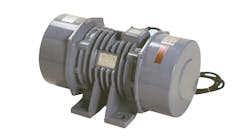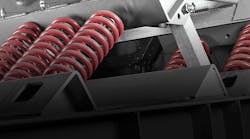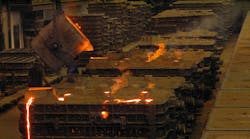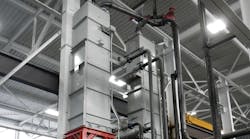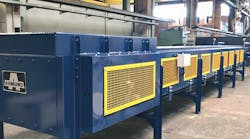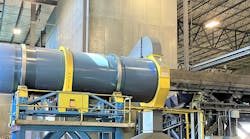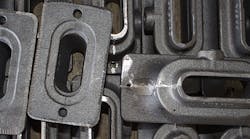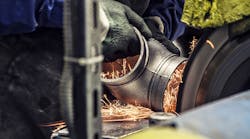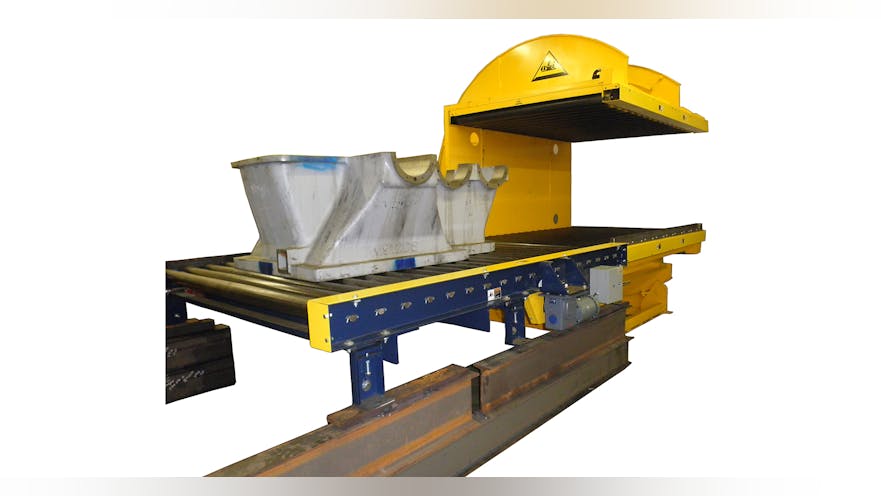Many metalcasting operations require a mold or casting to be turned over 180°, for separation, maintenance, cleaning, or production operations. Too often this process is carried out by haphazard methods that jeopardize worker safety or risk damaging the product, or both. A common method involves using an overhead crane to stand the object upright, teeter it over, and lay it down. This is mis-use of a crane that is designed exclusively for vertical lifts. It’s also more time-consuming and carries a higher risk of dropping the load.
Another method is rigging up the load with straps or chains and performing the same “stand up, teeter over, and lay down” process with a fork truck. The drawbacks are the same.
Don't feel bad if you've done this; you are not alone. But it doesn't need to continue. The Upender Inverter is a purpose-built product that performs this operation safely, securely, and more efficiently. It is a unique and innovative material handling device that will clamp the load securely and then smoothly turn it over 90° or 180° with the push of a button. It consists of a hydraulic scissors mechanism to clamp and hold the item during upending, and electro-mechanically operated rotating action.
Because the Upender Inverter is open on three sides, it can handle large or oversized items with some overhang. Standard models are offered up to 10,000 pounds capacity, but modified versions are available up to 50,000 pounds capacity for even the heaviest and most massive items. Being open on three sides also means the Upender Inverter can be used in two different configurations. It can be fed “into the mouth” as may be more visually intuitive, but this requires it to be unloaded on the other side after rotating. So, it also can be loaded from the side, which allows pass-through operation as well as loading and unloading from the same side.
The operation is very simple. Load the item into the Upender Inverter, then hold down Clamp “Close” button. The clamping mechanism will close on the item until the load is clamped securely and the button may be released.
Then, press the “CCW” button and the Upender Inverter will begin rotating and continue until the button is released or it reaches the 180° limit switch on the other side. Next, hold down Clamp “Open” button until the item is released or the clamping mechanism is fully retracted. The item can be unloaded and moved to the next stage of the process. Finally, the Upender Inverter can be used in reverse to turn over the next load, or the operator can hold down the “CW” button to rotate empty back to “Home” position to await the next cycle in the same direction.
There are a few popular configurations that can extend the versatility and efficiency of the Upender Inverter. One of these is a PLC-controlled auto-sequencing package that enables the entire process described here to be performed with one-touch from the operator. In cases like this, one operator could load the machine, start the cycle and, while the cycle is in process, get in position to unload when completed and prepare to start the next cycle. It also may be equipped with conveyors to streamline loading and unloading. By adding powered conveyors as well as the auto-sequencing package, a foundry can completely automate the rollover operation and integrate it into a conveyor line.
Another common mode of operation is to continue using an overhead crane, but using it properly by adding an external feed conveyor so that the item can be loaded on the feed conveyor with the overhead crane. Then the feed conveyor feeds the item into the Upender Inverter, complete the rollover process, and feeds it back out to the same feed conveyor to be picked up by the overhead crane and moved to the next stage. This style of operation can be automated, too.
Understanding the Upender Inverter system’s capabilities is an important to developing safe and streamlined processes, to handle mold or casting rollover operations. By implementing a system like this, foundries can modernize operations, avoiding any “hope nobody sees this...” type scenarios, improving safety and morale – and also boosting productivity. That's a solution where everyone benefits with tremendous benefits and it all starts with the idea.
Vida Novak is president of Air Technical Industries.

